Sydney Opera House
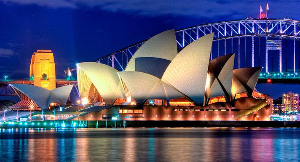 The Sydney Opera House is one of the most iconic and recognizable architectural landmarks in the world. Located in Sydney, Australia, it is a multi-venue performing arts center that hosts a variety of artistic and cultural events. The Sydney Opera House is a cultural icon that showcases the fusion of architecture, art, and performance. Its significance extends beyond its physical presence, making it a must-visit destination for tourists and a source of pride for Australians. Mention “Sydney, Australia” and most people think of the Opera House. Shaped like huge shells or billowing sails, this famous building on Sydney’s Bennelong Point graces the list of UNESCO World Heritage Sites and is one of the world’s great architectural icons. The location is stunning. Water surrounds the structure on three sides, and the Royal Botanic Gardens border it to the south. Danish architect, Jørn Utzon won an international competition for its design but withdrew from the project after technical and financing problems. Construction was finally completed in 1973 at a cost 10 times the original budget. By this time, Utzon had left the country, never returning to see his magnificent creation. Today, you can enjoy a performance here, dine at one of the restaurants, or see the highlights of the Sydney Opera House on a guided tour. The structure encompasses theaters, studios, a concert hall, exhibition rooms, and a cinema.
The Sydney Opera House is one of the most iconic and recognizable architectural landmarks in the world. Located in Sydney, Australia, it is a multi-venue performing arts center that hosts a variety of artistic and cultural events. The Sydney Opera House is a cultural icon that showcases the fusion of architecture, art, and performance. Its significance extends beyond its physical presence, making it a must-visit destination for tourists and a source of pride for Australians. Mention “Sydney, Australia” and most people think of the Opera House. Shaped like huge shells or billowing sails, this famous building on Sydney’s Bennelong Point graces the list of UNESCO World Heritage Sites and is one of the world’s great architectural icons. The location is stunning. Water surrounds the structure on three sides, and the Royal Botanic Gardens border it to the south. Danish architect, Jørn Utzon won an international competition for its design but withdrew from the project after technical and financing problems. Construction was finally completed in 1973 at a cost 10 times the original budget. By this time, Utzon had left the country, never returning to see his magnificent creation. Today, you can enjoy a performance here, dine at one of the restaurants, or see the highlights of the Sydney Opera House on a guided tour. The structure encompasses theaters, studios, a concert hall, exhibition rooms, and a cinema.
Great Barrier Reef
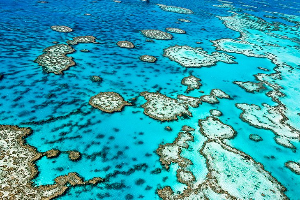 You can’t leave Australia without seeing the Great Barrier Reef. This World Heritage-listed natural wonder is one of the largest living structures on the planet. It’s so vast, you can see it from outer space. For divers, snorkelers, island aficionados, and nature lovers, it’s a bucket list destination.
You can’t leave Australia without seeing the Great Barrier Reef. This World Heritage-listed natural wonder is one of the largest living structures on the planet. It’s so vast, you can see it from outer space. For divers, snorkelers, island aficionados, and nature lovers, it’s a bucket list destination.
In 1975, the Great Barrier Reef Marine Park was established to protect its fragile ecosystems. These include more than 3,000 coral reefs; 600 continental islands, including the beautiful Whitsunday group; 300 coral cays; and inshore mangrove islands.
One of the seven wonders of the natural world, the park stretches for 2,300 kilometers along the state of Queensland, on Australia’s east coast (that’s about the distance between Mexico and Vancouver).
Not surprisingly, the Great Barrier Reef is one of the best places to visit in Australia for diving and snorkeling. The astounding array of marine life includes soft and hard corals, more than 1,600 species of tropical fish, sharks, dugongs, dolphins, turtles, rays, and giant clams. Prefer to stay dry? You can see the reef from underwater viewing stations and glass bottom boats.
Travelers have many options for visiting the Great Barrier Reef. You can cruise around the islands, hop aboard a sightseeing flight, take day trips to the islands, or snorkel and dive the reefs. On the mainland, the main launching points for tours are Cairns, Port Douglas, and Airlie Beach.
Ulura-Kata National Park
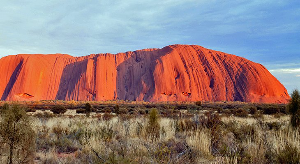 Uluru-Kata Tjuta National Park, located in the Northern Territory of Australia, is a UNESCO World Heritage-listed site known for its stunning natural beauty, rich indigenous cultural heritage, and iconic landmarks. Uluru-Kata Tjuta National Park offers a profound and awe-inspiring experience, inviting visitors to connect with the ancient landscapes, learn about indigenous culture, and appreciate the remarkable natural wonders of this sacred place.As the sun dips in the sky, sightseers gather to watch the colors of Uluru and Kata Tjuta transform in the shifting light. A great way to appreciate these sacred sites is to join a tour led by Aboriginal guides and rangers.
Uluru-Kata Tjuta National Park, located in the Northern Territory of Australia, is a UNESCO World Heritage-listed site known for its stunning natural beauty, rich indigenous cultural heritage, and iconic landmarks. Uluru-Kata Tjuta National Park offers a profound and awe-inspiring experience, inviting visitors to connect with the ancient landscapes, learn about indigenous culture, and appreciate the remarkable natural wonders of this sacred place.As the sun dips in the sky, sightseers gather to watch the colors of Uluru and Kata Tjuta transform in the shifting light. A great way to appreciate these sacred sites is to join a tour led by Aboriginal guides and rangers.
Melbourne
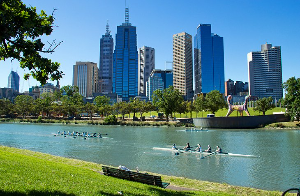 Melbourne, Australia’s second largest city, is a popular stop on many Australian itineraries – especially for culture vultures. Galleries, theaters, restaurants, shops, and its distinctly European feel are the main draws of this sophisticated city on the Yarra River. It’s also a green city, with parks, gardens, and open spaces occupying almost a third of its total area.
Melbourne, Australia’s second largest city, is a popular stop on many Australian itineraries – especially for culture vultures. Galleries, theaters, restaurants, shops, and its distinctly European feel are the main draws of this sophisticated city on the Yarra River. It’s also a green city, with parks, gardens, and open spaces occupying almost a third of its total area.
The cultural highlights of Melbourne are many. Gape at the masterpieces at the National Gallery of Victoria, watch a performance at Arts Centre Melbourne, or head to Federation Square. Here, you can browse Australian artworks at the Ian Potter Gallery and learn about the nation’s screen culture at the Australian Centre for the Moving Image.
Feel like getting back to nature? Follow the Aboriginal Heritage Walk at the Royal Botanic Gardens. And if sports culture is top of your agenda, catch a game at the Melbourne Cricket Ground. In summer, cricket is the sport of choice; in winter, it’s Australian Rules football.
Melbourne is also rich in history. You can see it in the Grand Victorian buildings funded by the Gold Rush, and you can feel it as you shop in the elegant arcades and the Queen Victoria Market, which has been selling goods to Melburnians for more than a century.
Bondi Beach
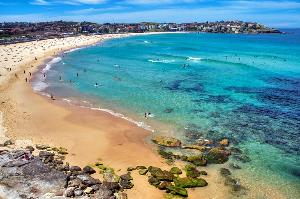 Bronzed bodies, blond sand, backpackers, and surf – throw it all together and you get one of the world’s most famous beaches. Only 15 minutes by car from Sydney’s city center, Bondi Beach is a great spot for a taste of Sydney’s beach culture. Bask on the golden sands, surf the breaks, or take a cool dip on a hot summer’s day (but stay between the flags).
Bronzed bodies, blond sand, backpackers, and surf – throw it all together and you get one of the world’s most famous beaches. Only 15 minutes by car from Sydney’s city center, Bondi Beach is a great spot for a taste of Sydney’s beach culture. Bask on the golden sands, surf the breaks, or take a cool dip on a hot summer’s day (but stay between the flags).
Few cities in the world lay claim to such an enticing slice of sand and sea so close to the city. No wonder it’s one of Sydney’s best beaches. And you’ll find some history here, too: Bondi hosts one of the oldest surf life saving clubs in the world.
Away from the shore, you’ll find plenty of things to do in Bondi. Take a stroll along the Bondi to Bronte coastal walk. It begins at the southern end of the beach and follows the coastline for six scenic kilometers along sandstone cliffs. And if you work up an appetite, you’ll find plenty of cafés and restaurants nearby. You can also hunt for bargains at the Sunday markets or swim some laps in the ocean pool.
Bondi also has a wild side. Crowds of tourists and locals gather here to celebrate Christmas, and ring in the New Year. It’s a favorite spot for travelers.
A word to the wise: If you’re taking a dip at Bondi, make sure you swim between the red and yellow flags. Strong rip tides often sweep unsuspecting swimmers out to sea, especially at the southern end of this kilometer-long strand. There’s a reason the Aussies made a reality TV show called Bondi Rescue.
Daintree National Forest
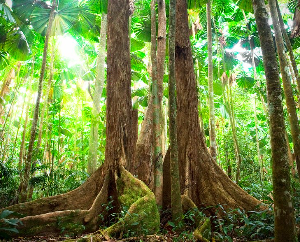 A Wet Tropics World Heritage Area, Daintree National Park in Far North Queensland is among the most ancient ecosystems on Earth. The area belongs to the Eastern Kuku Yalanji Aboriginal people, and many of its natural features hold great spiritual significance.
A Wet Tropics World Heritage Area, Daintree National Park in Far North Queensland is among the most ancient ecosystems on Earth. The area belongs to the Eastern Kuku Yalanji Aboriginal people, and many of its natural features hold great spiritual significance.
The park encompasses two main sections: Mossman Gorge, where crystal-clear waters gush over granite boulders, and Cape Tribulation, one of the most beautiful places to visit in Australia. Here, rainforest meets reef along the white sandy beaches of the Coral Sea. This stunning stretch of coast is one of the few places in the world where two of the planet’s richest ecosystems converge.
The park’s astounding biodiversity includes more than 18,000 plant species and a vast array of animal species, including the cassowary, crocodile, giant blue Ulysses butterfly, and the secretive Bennett’s tree kangaroo.
The resort town of Port Douglas just south of the park, is a great base to arrange wilderness safaris into the park.
Kakadu National Forest
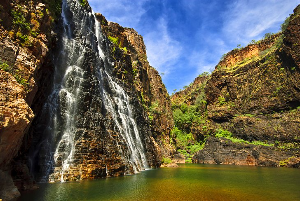 When it comes to wilderness areas, Kakadu National Park showcases the best of Australia. Covering more than 19,840 square kilometers in the Northern Territory, it’s the second largest national park in the world. Within its borders, you can explore monsoon rainforests, mangrove swamps, rivers, gorges, ancient rock paintings, wetlands, and waterfalls.
When it comes to wilderness areas, Kakadu National Park showcases the best of Australia. Covering more than 19,840 square kilometers in the Northern Territory, it’s the second largest national park in the world. Within its borders, you can explore monsoon rainforests, mangrove swamps, rivers, gorges, ancient rock paintings, wetlands, and waterfalls.
Kakadu is also home to an astounding diversity of wildlife. In addition to the many mammals, reptiles, and fish, more than 300 different species of birds make their home here, and both freshwater and saltwater crocodiles lurk in the wetlands.
To explore the park’s diverse ecosystems, hop aboard a cruise along the waterways, or hike the vast network of trails. You can also take a scenic flight.
Visiting Kakadu National Park from Darwin is easy during the dry season. It’s about a three-hour drive from the Northern Territory capital. In the wet season (Nov-April), many roads and attractions close due to heavy flooding, but the waterfalls and wetlands can be at their best.
Broome, Western Australia
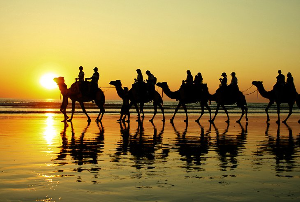 Broome, in Western Australia’s north, was once the pearl capital of the world. Today, it’s a booming tourist town and the gateway to the spectacular Kimberley region.
Broome, in Western Australia’s north, was once the pearl capital of the world. Today, it’s a booming tourist town and the gateway to the spectacular Kimberley region.
Broome’s star tourist attraction is Cable Beach. This seemingly endless stretch of white sand and turquoise water is one of Australia’s best beaches, and riding camels at sunset is one of the most popular things to do here.
Tourists also flock to Town Beach to witness the Staircase to the Moon. This phenomenon occurs during certain conditions between March and October, where the moonlight creates an optical illusion of steps leading to the moon.
Other Broome highlights include the red cliffs of Gantheaume Point, and the Malcolm Douglas Crocodile Park, where you can get up close to crocs, cassowaries, and kangaroos. If you’re looking for things to do in town, you can brush up on some local history at the Broome Historical Museum or catch a movie in a deck chair under a star-studded sky at Sun Pictures.
Pearl farm tours, whale watching trips, and Kimberley adventures are also high on the things to do list in Broome.



